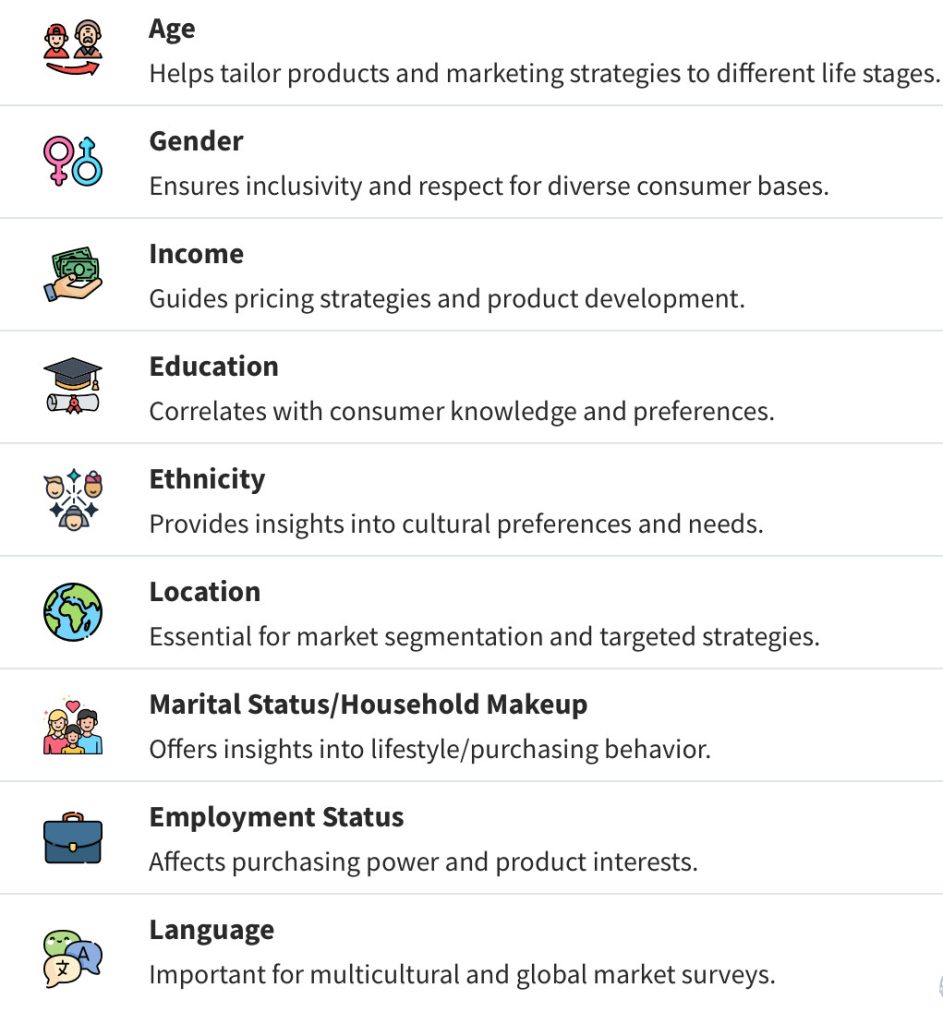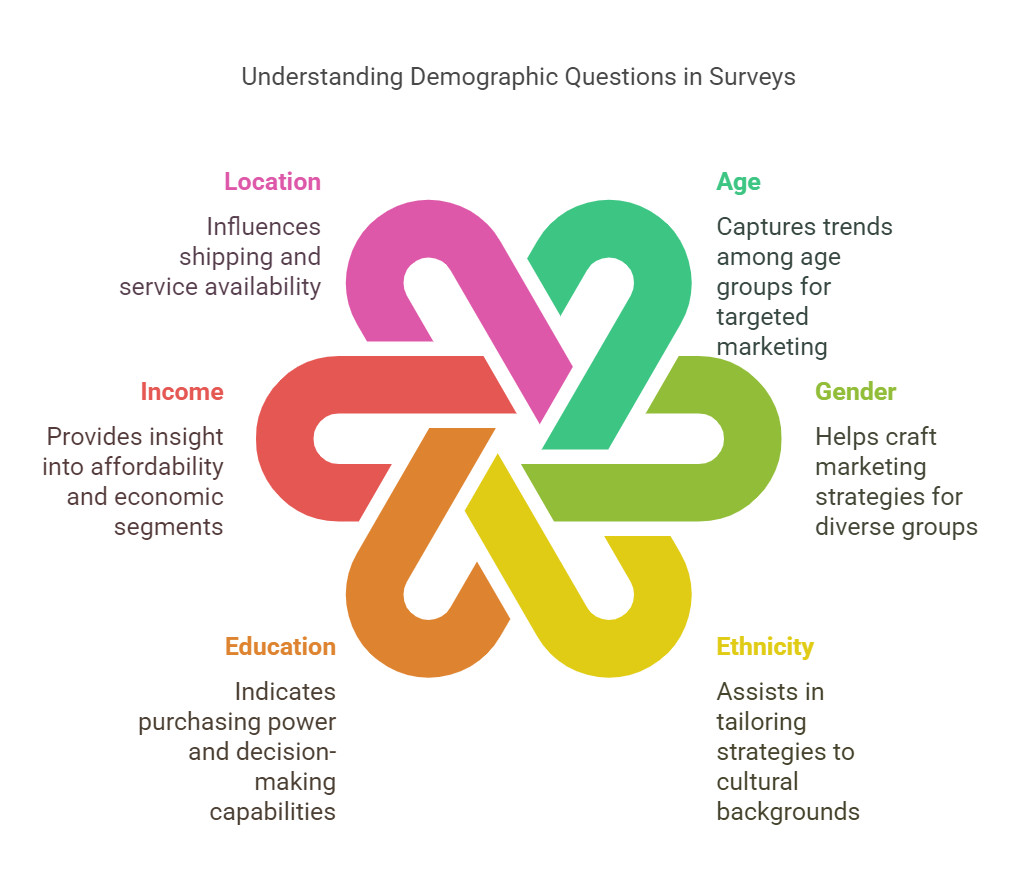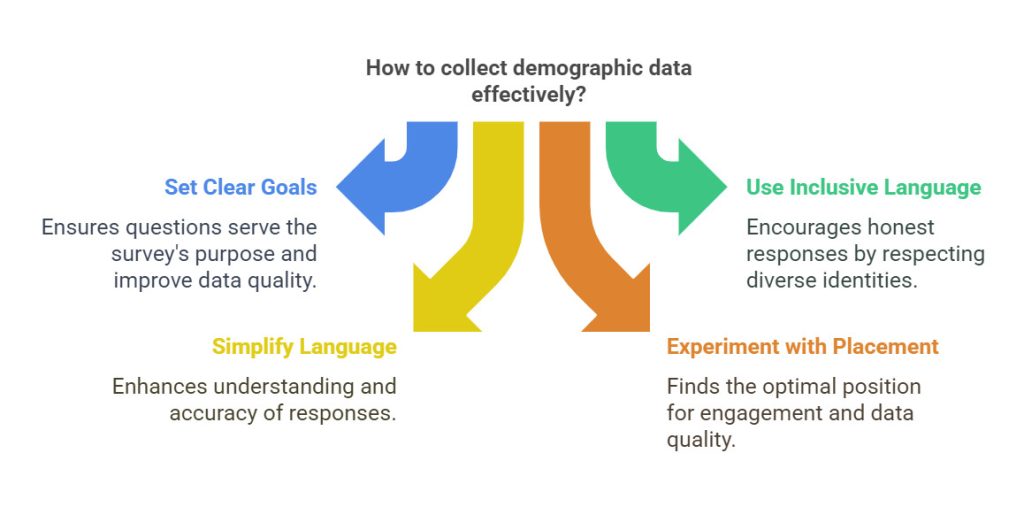- Research platform
Sources of information
Data analysis
Actions
- Solutions
For whom
Problems / Issues
- Materials
Materials
- About us
About us

Creating surveys needs you to ask the right demographic questions to truly understand your audience better. These questions matter. They help collect demographic data that leads to more accurate and reliable results. Our guide breaks down how to ask demographics on a survey and what makes them essential for your research.
Incorporating demographic questions for survey helps to match your objectives with valuable insights. You can learn about respondents in details. It impacts your inform business strategies and decision making. Such questions can guide and influence your approach towards your audience.
We go over types of demographic questions and share some examples. Ethical considerations should also be taken into account. Whether you are new at conducting surveys or refining your techniques, this post equips you with tools to gather and use demographic data effectively. Understand how these minor questions can create substantial insights about your target audience.
A demographic is a characteristic of a person or population that can be used to categorize and understand their behavior, needs, and preferences. Demographics encompass a wide range of characteristics, such as age, gender, ethnicity, location, income, education, occupation, marital status, and more. Understanding demographic data is essential for businesses, organizations, and researchers to develop effective marketing strategies, products, and services that meet the needs of their target audience.
Demographic data can be used to identify patterns and trends within a population, which can inform business decisions, policy development, and social programs. For example, understanding the age, income, and education level of a target audience can help businesses tailor their product development, pricing, and marketing strategies to better meet the needs of their customers. Similarly, demographic data can help policymakers understand the needs of different populations, guiding policy development and resource allocation to address those needs effectively.
By analyzing demographic characteristics, businesses can create more targeted and effective marketing campaigns, ensuring their messages resonate with the intended audience. This approach not only enhances customer satisfaction but also drives better business outcomes.
Demographic questions are essential. They help in collecting data about different traits of survey participants like age, gender, and education. This information is important for organizations that need to understand their audience and shape their marketing strategies accordingly.
Including demographic survey questions in surveys is very crucial. This data gives businesses insights into their target audience. By knowing who the audience is, companies can tailor their offerings. For examples, analyzing this data can reveal patterns that improve customer outreach and marketing techniques.
In market research, demographic questions serve a big purpose. They help to grasp consumer behavior and preferences. Understanding these trends can improve product designs and marketing strategies. Thus, demographic insights make campaigns more resonant with the audience. Moreover, they help in fostering customer satisfaction and retention. These questions are central, not just optional add-ons in survey design.
In conclusion, asking demographic questions in surveys is necessary. It helps gather vital insights into audience characteristics. This understanding boosts market research efforts and enriches customer experiences, which leads to improved business results over time.

When you design surveys, it’s crucial to know the types of demographic questions available. These questions are vital for gathering important insights. They help you segment your audience properly and adjust services to better meet needs.
Common demographic questions include age, gender, and ethnicity. Capturing the age of respondents shows trends among various age groups, enabling businesses to target products effectively. Knowing the gender and ethnicity of participants helps in crafting marketing strategies that appeal to diverse groups.
Also, collecting education and income information proves to be significant. Data on education highlights potential purchasing power and decision-making capabilities. Meanwhile, knowing annual household income provides insight into affordability and the audience’s economic segments that affect product marketing directly.
Equally, demographic questions require attention to location and marital status. Geographic data reveals where customers are based, influencing shipping and service availability significantly. Knowing marital status can refine customer segmentation, helping marketers promote family products to married people or target single individuals with tailored interests.
In conclusion, using various types of demographic questions such as age, gender, ethnicity, income, and location enhances understanding of participant profiles. This targeted approach boosts the survey’s effectiveness and provides valuable business insights.
This groundwork prepares us to discuss best practices when collecting demographic data. Ensuring your method is effective helps gather the required information with respect.
Collecting demographic data for surveys needs best practices. This makes sure the info is helpful and relevant. Below are key practices to think about when you make and administer demographic questions for survey.
By applying these best practices, the accuracy of your demographic data collection process will improve. This makes it easier to analyze and benefit from important data.
This section has shared tips on effective collection of demographic data. In the next part, we will look at how to ask demographics on a survey effectively. Ensuring your method is both respectful and clear.

When you design a survey, it's vital to incorporate demographic segmentation to categorize target markets effectively based on descriptive data about people's lives, such as age, location, and socioeconomic background. Sensitive questions need to be worded carefully to get honest responses. For example, instead of asking income directly, present ranges. This would make responders more at ease.
Another good method is including optional responses. Letting users skip questions or add answers like “Prefer not to say” raises comfort. It recognizes not all will feel ok sharing personal info, thus it can boost response rates.
Avoid making assumptions about gender and identity. Try an open-ended format for gender. Or, offer choices like “Male, Female, Non-binary, Prefer to self-describe, or Prefer not to say.” This improves data accuracy and respects people's identities.
By using these methods while creating demographic questions for the survey, acknowledgement of privacy increases, leading to accurate, reliable data for good decision making and analysis.
Creating a survey means you need to ask demographic questions. These demographic questions for survey help gain demographic survey insights into your audience. They assist in understanding how age, gender, or income impacts opinions. Here are some common examples of these questions:
These demographic questions collect data and allow for adaptable responses. This flexibility matters. For example, offering ‘Prefer not to say’ keeps privacy intact while letting people take part in the survey. How to ask demographics on a survey should focus on comfort.
Inclusivity is also key when forming demographic questions. Respondents feel comfy when they see their identity recognized in surveys. For example, providing options for various genders, not just male or female, build inclusivity. This practice helps increase response rates.
Understanding why include demographics in a survey needs attention. It reveal significant benefits for research and strategy development. Collecting demographic information creates a clear picture for analyses. It shows trends that would not be visible without these questions.
Adding demographic questions for survey can boost the value of collected data. One clear advantage is better targeting in marketing strategies. When firms know the demographics of respondents, they can effectively segment their audience and identify trends. This helps in crafting marketing messages that appeal to certain groups.
Understanding customer behavior is another significant benefit. Insights into demographics can help businesses see how different groups react to products, services, or marketing efforts. For example, younger shoppers may favor specific features, while older customers might follow different buying patterns.
Moreover, demographic questions help validate survey outcomes. Researchers can compare survey results with demographic data to check if the sample is representative. This analysis let them find out if opinions vary across demographics or if certain biases present. Validation is essential for reliable findings.
In summary, demographic questions, like targeting for marketing, understanding customer habits, and validating findings, show how vital it is for companies to use demographic data well. Insights shape marketing plans and product development, paving the way for better business decisions.
Having discussed the benefits of demographic questions for survey, next, we will explore effective ways to use this demographic data in business strategies. This ensures companies gain maximum insights from their surveys.
Demographic questions are vital for guiding marketing choices and developing business strategies. Companies can analyze demographic questions for survey responses to build clear profiles of their target audience. This helps in spotting trends and adjusting services to fit diverse consumer groups. Knowing traits like age, income, or location can aid businesses crafting specific buyer personas, reflecting audience diversity while improving marketing effectiveness.
Additionally, including demographic questions contributes to understanding customer satisfaction. By examining how demographic segments react, businesses can adapt their products and customer service strategies. This thoughtful segmentation allows tailored promotional strategies that enhance customer experience and build loyalty, crucial for brand strength.
Moreover, demographic data can give insights into market needs, allowing firms to manage resources wisely. For instance, when a business identifies that a majority of its buyers are young adults, it can direct more money towards ads attracting that demographic. This leads to better conversion rates and improved sales over time.
Utilizing demographic analysis helps companies not only to enhance offerings but also plan strategically. This approach is critical in today’s fast-moving market, where the ability to address consumer demands correlates with success and growth.
As businesses engage with ever-changing consumer preferences, the role of demographic questions becomes crucial. They affect marketing directions and influence product designs. Grasping the subtleties of demographic insights helps foster a welcoming and engaging experience for many customers.
With these advantages, it is important to address ethical concerns regarding demographic data. Collecting this information must always involve priority on privacy and informed consent, creating trust with consumers while balancing business needs.
When you collect demographic questions for survey data, ethical considerations must be significant. Privacy and consent are essential at every point during data collection. Participants should understand the purpose of the survey clearly. This makes trust build and encourages participation.
Another point is to encourage honest responses. Creating demographic questions that respect individual identities allows participants to feel safe sharing their data. Avoid questions that seem intrusive, since this improves response rates and data quality. Giving clear instructions can also help.
Sensitivity to diverse identities is critical when crafting survey questions. Recognizing the various identities, such as gender, sexual orientation, and ethnicity, shows respect for experiences. Using inclusive language and allowing self-identification enhances the ethical nature of the survey. Options like open-ended gender responses respects the complex identities.
In summary, think about ethics in every stage of surveys that ask demographic questions. Prioritizing consent, encouraging honesty, and showing respect for identities improves the data quality. This also enhances the overall experience for the participants during the process.
Demographic survey templates are pre-designed surveys that ask a series of demographic questions to gather information about a population’s characteristics. These templates are invaluable tools for collecting demographic data, which can inform business decisions, policy development, and social programs.
Demographic survey templates typically include a wide range of questions, such as:
These templates can be customized to meet the specific needs of a business or organization. For instance, a company might add questions about their target audience’s interests, behaviors, or preferences to gain deeper insights.
Demographic survey templates can be used in various settings, including market research, academic research, and social programs. They can be administered online or offline and are suitable for collecting data from both large and small sample sizes.
By using demographic survey templates, businesses and organizations can gather valuable insights about their target audience. This information can inform product development, marketing strategies, and policy development, ensuring that efforts are aligned with the needs and preferences of the audience. Collecting demographic data through these templates helps in creating more effective and targeted marketing campaigns, ultimately leading to better engagement and business success.
In conclusion, understanding the demographic questions is essential. These questions help gather data to support strategic choices. We defined demographic questions and stressed their role in knowing who responds. We looked at several types of demographic questions and shared best practices for collecting responses.
We also provided tips on how to ask demographics on a survey. Including demographic questions for survey designs boosts response quality. This data helps shape marketing strategies and improves engagement with customers.
Now that you know these key points, apply demographic questions in your surveys. Collecting this info supports analysis and encourages transparency in processes. Using demographic data well can lead to informed strategies that align with your audience's needs. This practice could enhance your projects.
Utilize the insights from demographic inquiries wisely. Your research can evolve into clear strategies that bring growth and better understanding.
Copyright © 2023. YourCX. All rights reserved — Design by Proformat